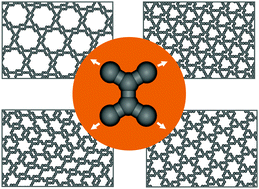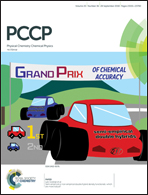On-surface self-assembly of tetratopic molecular building blocks†
Abstract
Self-assembly of functional molecules on solid substrates has recently attracted special attention as a versatile method for the fabrication of low dimensional nanostructures with tailorable properties. In this contribution, using theoretical modeling, we demonstrate how the architecture of 2D molecular assemblies can be predicted based on the individual properties of elementary building blocks at play. To that end a model star-shaped tetratopic molecule is used and its self-assembly on a (111) surface is simulated using the lattice Monte Carlo method. Several test cases are studied in which the molecule bears terminal arm centers providing interactions with differently encoded directionality. Our theoretical results show that manipulation of the interaction directions can be an effective way to direct the self-assembly towards extended periodic superstructures (2D crystals) as well as to create assemblies characterized by a lower degree of order, including glassy overlayers and quasi one-dimensional molecular connections. The obtained structures are described and classified with respect to their main geometric parameters. A small library of the tetratopic molecules and the corresponding superstructures is provided to categorize the structure–property relationship in the modeled systems. The results of our simulations can be helpful to 2D crystal engineering and surface-confined polymerization techniques as they give hints on how to functionalize tetrapod organic building blocks which would be able to create superstructures with predefined spatial organization and range of order.



 Please wait while we load your content...
Please wait while we load your content...